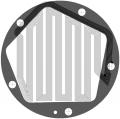Results 31 to 40 of 126
Thread: Z axis calibration idea
-
05-13-2014, 03:48 PM #31
I apologize if these questions are redundant, but how many "dots per inch" is required for proper z-axis resolution of a general purpose 3-D printer? And assuming our z-axis measuring equipment was capable of measuring in increments that were infinitely small, at what point does the argument become moot because the laser's field of view in our Peachys (or perhaps the behavior of the MakerJuice in relation to the laser that we're using) can't keep up with the performance level? In other words, I guess, what's the lowest resolution that everyone would be okay with?
-
05-13-2014, 04:06 PM #32Staff Engineer

- Join Date
- Dec 2013
- Location
- Georgia
- Posts
- 934
The resolution of the Peachy is a tricky thing, because it's analog rather than digital. It has a measurable precision, but that can change drastically based on the software (which is still changing quite a bit) and the clarity of the sound card used. Possibly even the quality and shielding of the cable, being able to actually see sound quality as a physical object can really turn someone into an audiophile.

Also, the laser currently has to be calibrated by eye, meaning the overall scale would be hard to get better than +-.5mm, but details smaller than that would still show up if you have the sound quality for it.
-
05-13-2014, 04:06 PM #33Engineer-in-Training

- Join Date
- Oct 2013
- Posts
- 219
As an example, the Form1 3D printer can resolve Z to .001 inches. There is no reason why Peachy can not match that as the two use very similar technology. I think the Peachy hardware seems excellent. The only question mark for me relates to the Z axis calibration in terms of drip control and the software corrections for each Z layer. The beta prints so far all appear to have Z dimension problems, hence this thread to identify a way of doing closed loop Z with a basic Peachy.
I meant to add that the chip used in digital vernier calipers looks very interesting. http://www.ebay.co.uk/itm/6-Digital-...item2ec3149f37Last edited by mike_biddell; 05-13-2014 at 04:16 PM.
-
05-13-2014, 04:07 PM #34Technician

- Join Date
- Apr 2014
- Posts
- 88
in a sense, the argumant is moot,
as get better with our calibrations and others develop ways of fine tuning the laser and mirrors we would be able to get finer and finer resolutions possibly even the the point of nano. the whole purpose of this thread is to try and make the Peachy the most reliable 3D printer on the market even if everything we are talking about is to be done after market. to be able for the printer to accurately know what its current Z height is simply means you get that much more precise of a final product with less fussing around.
3D printing technology is constantly advancing, and there is no law that states that it has to advance in a certain order, if we can measure more accurately than our printer can print it just gives us an excuse to make the printer more accurate to match.
-
05-13-2014, 04:26 PM #35Engineer-in-Training

- Join Date
- Oct 2013
- Posts
- 219
An interesting article on reading data from digital calipers http://www.instructables.com/id/Read...n-Arduino-USB/
Could we get a float to turn the caliper mechanicals?
-
05-14-2014, 04:09 AM #36Engineer-in-Training

- Join Date
- Oct 2013
- Posts
- 219
Just had a fiddle about with my digital calipers and I am really warming to the idea. I can open them fully and zero them (do this at the start of the print). As you close them, the reading increases as expected but with a negative sign (so just get picaxe/arduino to ignore the sign). The caliper is a bit stiff and would need loosening up, but not sure whether this would affect the capacitance. The Z value is easy to read with a PIC chip and you can simply look at the display to get current Z height (ignoring the sign). The resolution required could be set using dip switches (say 8), which would give 256 combinations of vertical res. The PIC just reads the dip switch pattern to get the required Z res. The PIC simply then turns on a solenoid or pump until required Z reached then pulses the mic and turns pump/solenoid OFF. Then delay to allow hardening then pump on again.
-
05-16-2014, 07:45 AM #37Engineer-in-Training

- Join Date
- Oct 2013
- Posts
- 219
I've just splashed out on these calipers..... will report back to see if I can loosen them enough to be float operated. These can resolve to 10 thou. They operate off capacitance ............. will report back when I've had a go. http://www.ebay.co.uk/itm/4006804750...84.m1439.l2649
-
05-16-2014, 12:15 PM #38
love the idea... wonder if they are good, I would buy some for personnal use! :P
-
05-16-2014, 12:32 PM #39Engineer-in-Training

- Join Date
- Oct 2013
- Posts
- 219
sebastian.... they are very useful for general purpose use...... will let you know how my experiments progress.
-
05-16-2014, 12:35 PM #40Technician

- Join Date
- Mar 2014
- Posts
- 94
I don't know if this has already been discussed, but what about using a Kalman filter (which is just something to be implemented in software) to make use of the information from the drip and whatever is used to accurately measure the present liquid level (such as the caliper)? This way the caliper (or whatever equivalent used) would give it good accuracy, and the individual drips would give it amazing resolution.
For example say each drip adds 0.001 mm. Then even if the caliper had poor resolution the Kalman filter would just "trust" the drip in the short run giving .001 mm resolution, and then use the caliper data to prevent it from drifting after several drops. So with this system you would still have to do a test calibration of the drip system to understand roughly how many drips it takes to go up a given height, but then after that it would have great accuracy and awesome resolution. The accuracy would be as good as the caliper and the resolution as good as the drips.Last edited by jstrack2; 05-16-2014 at 05:59 PM.





 Reply With Quote
Reply With Quote







Ender 3 Neo - Jam Problem
Yesterday, 03:06 PM in Tips, Tricks and Tech Help